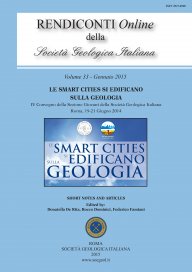
Preliminary geochemical and geological characterization of the thermal site of Spezzano Albanese (Calabria, South Italy)
Giovanni Vespasiano (*), Carmine Apollaro (*), Francesco Muto (**), Rosanna De Rosa (*) & Teresa Critelli (*)
(*) Department of Biology, Ecology and Earth Sciences, University of Calabria, Via Ponte Bucci 4, cubo 15B, 87036 Arcavacata di Rende (CS), Italy. E-mail: first.giovanni.vespasiano@unical.it
(**) Department of Engineering for Environment, Territory and Chemical Engineering, University of Calabria, Via Ponte Bucci 4, cubo 45B, 87036 Arcavacata di Rende (CS), Italy.
Volume: 33/2015
Pages: 108-110
Abstract
Waters discharging at the Spezzano Albanese spring come from a deep circuit hosted in the Ophiolitic rocks of the Diamante Unit (phyllites and metabasalts, Liberi et al., 2006; Vespasiano et al., 2012b). The unit contains a warm deep aquifer acting as a sort of well-mixed reservoir; during the ascent the waters interact with Tertiary and Quaternary deposits (conglomerates, sands, gypsum and clays with levels of halite) that give them a characteristic composition with near neutral pH value of 7.05 to 7.57, outlet temperatures of 20.16° to 26.6°C, variable redox potentials (–0.25 to 0.28 V) and total dissolved solids from 848 to 9720 ppm.
During deep circulation, the waters extract heat from reservoir rocks, attaining thermo-chemical equilibrium and rise relatively quickly to the surface, along sub-vertical faults and fractures, preserving part of their physical and chemical characteristics (Vespasiano et al., 2014).
Water chemistry was discussed by means of the triangular diagrams among major anionic/cationic constituents and correlation plots. Triangular diagrams show a Na-Cl composition characterized by high bacterial sulfate reduction. Correlation diagrams attest a high calcite and silica precipitation (likely scaling effect) and show a 1:1 ratio between sodium and chlorine that underline an interaction with halite. This represents only a preliminary study that demonstrates the importance of the geochemical characterization as powerful tool to improve the knowledge of natural environment and to predict and avoid problems linked to the study of thermal sites (Gurrieri et al., 1984; Duchi et al., 1991; Italiano et al., 2010).
Keywords
Get Full Text